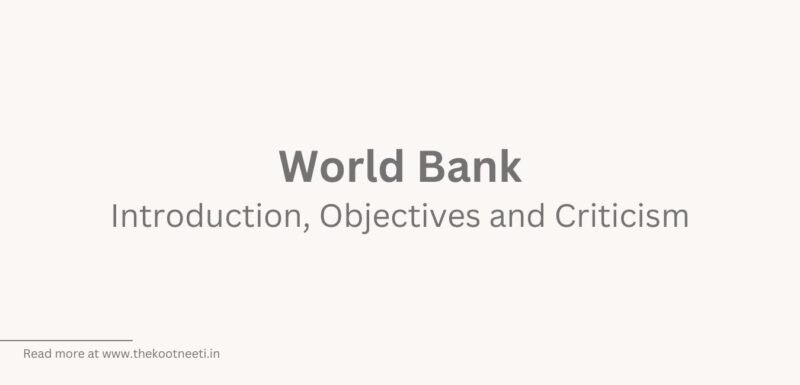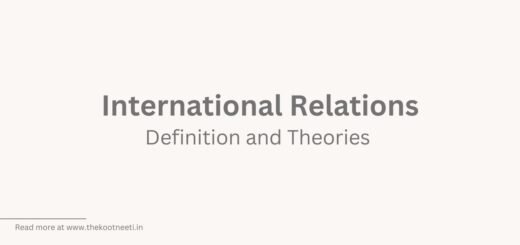World Bank: Introduction, Objectives and Criticism

The World Bank is an international financial institution that provides loans and grants to developing countries for the purpose of promoting economic growth and reducing poverty. The World Bank was established in 1944 as part of the Bretton Woods Agreement, which established the rules for international economic cooperation following World War II. The World Bank is headquartered in Washington, D.C.
The World Bank is made up of two main entities: the International Bank for Reconstruction and Development (IBRD), which provides loans and financial assistance to middle-income and creditworthy poorer countries, and the International Development Association (IDA), which provides grants and low-interest loans to the poorest countries.
The World Bank is owned by its member countries, which are represented by a Board of Governors. The member countries elect a President, who is responsible for the overall direction and management of the bank.
Goals and Objectives
The World Bank’s overarching goal is to reduce poverty and promote sustainable economic development in developing countries. To achieve this goal, the World Bank has two main objectives:
- Eradicating Extreme Poverty: The World Bank aims to reduce the percentage of people living in extreme poverty (defined as living on less than $1.90 per day) to no more than 3% by 2030. This includes providing financial assistance, policy advice, and technical assistance to help countries promote economic growth and improve the livelihoods of their poorest citizens.
- Boosting Shared Prosperity: The World Bank aims to promote income growth among the bottom 40% of the population in every country. By increasing the income and economic opportunities of these individuals and households, the World Bank hopes to reduce poverty and inequality and promote more inclusive economic growth.
To achieve these goals, the World Bank focuses on a wide range of areas including:
- Supporting development in key sectors such as agriculture, education, health, infrastructure, and social protection.
- Advising countries on macroeconomic and sectoral policies.
- Supporting institutions and programs that help poor people access finance, markets, and information.
- Helping countries strengthen their capacity to manage public resources and promote good governance.
- Supporting efforts to fight corruption and build social and economic resilience.
- Working to address the needs of the poorest and most vulnerable groups, including women, children, and people living with disabilities.
- Investing in knowledge, innovation and technology to help countries reach their development goals.
Criticism
The World Bank has been criticized by various groups over the years for a number of different reasons. Some of the main criticisms include:
- Lack of Transparency: Critics argue that the World Bank operates with a lack of transparency, making it difficult for stakeholders to understand its decision-making processes and to hold the bank accountable.
- Conditionality: Some critics argue that the World Bank uses its financial assistance as leverage to impose economic policy conditions on recipient countries, often without taking into account the unique economic and social conditions of these countries.
- Environmental and Social Impact: The World Bank has been criticized for funding projects that have negative environmental and social impacts, particularly in relation to indigenous people and vulnerable communities.
- Focusing on Economic Growth: The World Bank has been criticized for placing too much emphasis on economic growth and not enough on poverty reduction and income distribution.
- Lack of Democracy: Critics argue that the World Bank’s governance structure is undemocratic, as the majority of voting power is held by developed countries and the bank’s president is always an American nominee.
- Role in Neoliberal Development: Some critics argue that World Bank promotes a neoliberal development agenda which prioritizes market-oriented policies and private sector development over social welfare and public goods.
World Bank and India
India is a member of the World Bank and has received financial assistance and support from the organization for a number of development projects. The World Bank has been working in India since the 1950s and has provided the country with over $300 billion in loans and grants.
The World Bank has supported a wide range of projects in India, including investments in infrastructure, such as roads, ports, and power plants; programs to improve education and health services; and initiatives to promote economic growth and reduce poverty.
The World Bank has also provided technical assistance and policy advice to the Indian government on a range of development issues. For example, the bank has supported the government’s efforts to reform the power sector and to improve the business climate by simplifying regulations and increasing transparency.
Overall, the World Bank’s engagement with India has contributed to the country’s economic development and helped to improve the living standards of its people. However, the World Bank’s programs in India have also faced criticism, including concerns about the environmental and social impacts of some projects, as well as questions about the bank’s accountability and transparency.


















